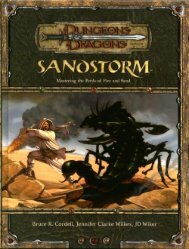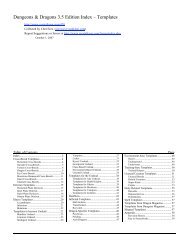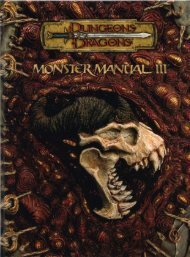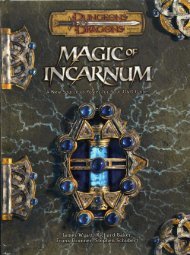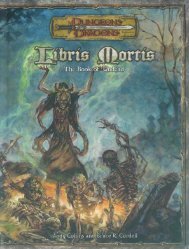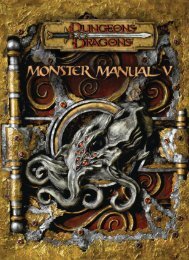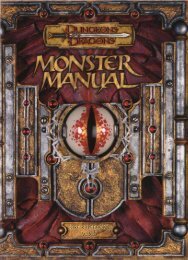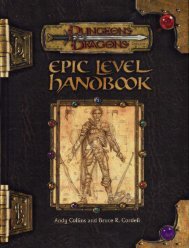Exemplars of Evil
Exemplars of Evil
Exemplars of Evil
You also want an ePaper? Increase the reach of your titles
YUMPU automatically turns print PDFs into web optimized ePapers that Google loves.
CHAPTER 1<br />
GREAT<br />
VILLAINS<br />
30<br />
masters. Minions can employ similar spells, use magic items<br />
that fit a particular theme, or employ lackeys that resemble<br />
or reflect the nature <strong>of</strong> their master.<br />
LACKEYS<br />
Beneath minions in the pecking order are lackeys, less significant<br />
characters who live only to serve and protect their<br />
master. Lackeys are less impressive than minions and have<br />
lower Challenge Ratings. They might have levels in NPC<br />
classes, and they resemble the usual types <strong>of</strong> cannon fodder<br />
that player characters fight on a regular basis.<br />
A villain’s number <strong>of</strong> lackeys depends on her Charisma<br />
modifier and her Challenge Rating. Add the two values<br />
together and consult Table 1–2: Typical Lackeys. (For example,<br />
a villain whose CR + Cha modifier equals 14 typically has<br />
twenty lackeys <strong>of</strong> CR 1, four lackeys <strong>of</strong> CR 2, and two lackeys<br />
<strong>of</strong> CR 3.) The table is meant only as a guide, so feel free to<br />
modify the numbers to meet your needs.<br />
Table 1–2: Typical Lackeys<br />
Villain’s CR — Number <strong>of</strong> Lackeys by CR —<br />
+ Cha Mod 1 2 3 4 5 6 7 8 9 10<br />
9 or lower — — — — — — — — — —<br />
10 2 — — — — — — — — —<br />
11 5 1 — — — — — — — —<br />
12 10 2 — — — — — — — —<br />
13 15 3 1 — — — — — — —<br />
14 20 4 2 — — — — — — —<br />
15 25 5 3 1 — — — — — —<br />
16 30 6 3 2 — — — — — —<br />
17 35 7 4 2 — — — — — —<br />
18 40 8 4 2 — — — — — —<br />
19 45 9 5 3 1 — — — — —<br />
20 50 10 5 3 2 — — — — —<br />
21 75 15 7 4 2 — — — — —<br />
22 100 20 10 5 3 1 — — — —<br />
23 125 25 13 7 4 2 — — — —<br />
24 150 30 15 8 4 2 — — — —<br />
25 175 35 18 9 5 3 1 — — —<br />
26 200 40 20 10 5 3 2 — — —<br />
27 250 50 25 13 7 4 2 — — —<br />
28 300 60 30 15 8 4 2 1 — —<br />
29 400 80 40 20 10 5 3 2 1 —<br />
30 500 100 50 25 12 6 3 2 1 1<br />
Each +1 +100 +30 +10 +5 +2 +1 +1/2 +1/3 +1/4 +1/4<br />
Assembling the Lackeys<br />
You have a lot <strong>of</strong> freedom when choosing the types, classes,<br />
and races <strong>of</strong> the members <strong>of</strong> a villain’s organization. Although<br />
any monster or character could be found in the group, keep<br />
in mind the villain’s theme and alignment, as well as the<br />
alignments <strong>of</strong> the lackeys you select.<br />
As a rule <strong>of</strong> thumb, lackeys should have a uniform alignment;<br />
when selecting monsters, always use the monster’s<br />
listed alignment. You should reserve unusual monster and<br />
alignment combinations for the minions and villains.<br />
No matter how many lackeys constitute the villain’s organization,<br />
do not define them all at once. Instead, use them<br />
the way that a wizard uses a spell slot. When you build an<br />
adventure that features the villain’s group, select lackeys that<br />
are appropriate to the adventure and the PC levels. When<br />
lackeys are slain, simply remove them from the villain’s pool<br />
<strong>of</strong> servants.<br />
Minions, Lackeys, and the Leadership Feat<br />
The Leadership feat (PH 97 and DMG 106) is primarily<br />
intended to address how player characters accumulate followers<br />
as they gain levels and garner a reputation for greatness.<br />
As such, the feat is unsuitable for villains, who <strong>of</strong>ten spend<br />
more time building a network <strong>of</strong> servants, brokering deals<br />
with monstrous entities, and putting terrifying plots into<br />
motion. Furthermore, villains—by their very nature—are<br />
not the sorts <strong>of</strong> individuals who accomplish heroic deeds or<br />
have impressive qualities, so their leadership scores <strong>of</strong>ten<br />
suffer due to bad behavior. Still, if you choose to give your<br />
villain the Leadership feat, she gains a cohort and followers<br />
in addition to any servants she accumulates by dint <strong>of</strong><br />
her villainy.<br />
ORGANIZATIONAL STRUCTURE<br />
Taken as a whole, a villain’s lackeys and minions constitute<br />
her organization. They work on behalf <strong>of</strong> the villain,<br />
undertaking missions, gathering information, protecting<br />
her lair, and performing countless other duties and tasks.<br />
A villain’s servants are representatives <strong>of</strong> her will in the<br />
setting, and the PCs must fight them before they confront<br />
the major adversary.<br />
Hierarchy<br />
The villain’s hierarchy defines how she organizes her lackeys.<br />
This arrangement should reflect her goals and alignment:<br />
Chaotic villains have loose hierarchies, and lawful characters<br />
have rigid ones.<br />
Loose (Chaotic): A loose hierarchy has no formal structure,<br />
and members can come and go over time. For these groups to<br />
function, they must have a unifying purpose, a common goal,<br />
or some other aspect that is shared by all members. Examples<br />
include worship <strong>of</strong> the same deity, hatred <strong>of</strong> a particular race,<br />
or devotion to a common ideal.<br />
Arranging a loose organization requires little preparation.<br />
Simply use the lackeys as you need them, assembling them<br />
in whatever structure works best for each situation.<br />
Authoritarian (Lawful): In an authoritarian organization—the<br />
opposite <strong>of</strong> a loose hierarchy—everyone knows<br />
their place. The leaders issue orders to various lieutenants,<br />
who pass them along to their subordinates, who finally<br />
give the commands to the grunts. This kind <strong>of</strong> organization<br />
is the most common type for villains who have a<br />
militaristic bent.<br />
An authoritarian hierarchy is easy to assemble. Place the<br />
villain at the top, with her minions directly beneath. To each<br />
minion, attach one <strong>of</strong> the highest-level lackeys in the organization.<br />
To each high-level lackey, attach an equal number <strong>of</strong><br />
lower-level lackeys, and continue until you reach the 1st-level<br />
lackeys, who should be divided evenly among the 2nd-level<br />
ones. Lackeys or minions on the same tier communicate with<br />
one another.<br />
Segmented (Any): In a segmented hierarchy, a villain<br />
divides her servants into smaller isolated cells. Most members<br />
<strong>of</strong> a particular cell are not aware <strong>of</strong> the members <strong>of</strong> any<br />
other cells. The villain can have multiple cells perform the<br />
same task to ensure that her minions achieve the desired<br />
outcome, or she can weave a complex web <strong>of</strong> orders so that<br />
cells unknowingly assist each other. In each cell, one member<br />
also belongs to a different cell, and one member from that



